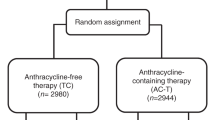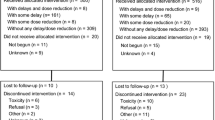Abstract
Purpose: To comparatively analyse the risk of recurrence at given times after surgery for breast cancer patients receiving or not receiving adjuvant CMF.
Patients and methods: A total of 1452 node positive patients, who entered controlled clinical trials carried out at the Milan Cancer Institute and underwent radical or modified radical mastectomy for operable breast cancer, were examined. In 575 cases no further treatment was performed, whereas 877 pts were given 6 or 12 courses of adjuvant Cyclophosphamide, Methotrexate, Fluorouracil (CMF). The recurrence risk was estimated by the event-specific hazard rate for first failure and distant metastases, and, following Efron, hazard rates were fitted by logistic regression models.
Results: The hazard rate for first failure and distant metastases showed a double peaked pattern for both treated patients and controls, with a first major peak at about 18–24 months from surgery (early metastases), a second minor peak at the 5th–6th year, and a tapered plateau-like tail extending over 10 years from surgery (late metastases). As expected, the recurrence risk of CMF treated patients was lower than the corresponding risk of patients undergoing surgery only. However, the difference was highly evident for early recurrences, while it declined and disappeared afterwards.
Conclusion: Our findings confirm previous reports on patients not receiving adjuvant chemotherapy, suggesting that the recurrence risk for operable breast cancer has a multipeak pattern. As far as CMF treated patients are concerned, the unchanged peak timing together with the early recurrence risk reduction in comparison to controls are much more consistent with the real nonappearance of some early recurrences (putatively ‘cured’ patients) than with the delay in their manifestation. As late relapsing patients seem to have at most marginal benefits from adjuvant CMF, ways to recognize patients doomed to have late recurrence and new ways for treating micrometastases resulting in late recurrences are required.
Similar content being viewed by others
References
Early Breast Cancer Trialists' Collaborative Group: Systemic treatment of early breast cancer by hormonal, cytotoxic, or immune therapy. Lancet 339: 1–15, 71–85, 1992
Bonadonna G, Valagussa P, Moliterni A, Zambetti M, Brambilla C: Adjuvant Cyclophosphamide, Methotrexate and Fluorouracil in node positive breast cancer. The results of 20 years of follow-up. N Engl J Med 332: 901–906, 1995
Gamel JW, Vogel RL, Mc Lean IW: Assessing the impact of adjuvant therapy on cure rate for state 2 breast carcinoma. Br J Cancer 68: 115–118, 1993
Tancini G, Bajetta E, Marchini S, Valagussa P, Bonadonna G, Veronesi U: Preliminary 3-year results of 12 versus 6 cycles of surgical adjuvant CMF in premenopausal breast cancer. Cancer Clin Trials 2: 285–292, 1979
Cutler SJ, Ederer F: Maximum utilization of the life-table method in analyzing survival. J Chronic Dis 8: 699–712, 1958
Marubini E, Valsecchi MG: Analysing survival data from clinical trials and observational studies. Wiley, Chichester (UK), 1995, pp. 331–364
Efron B: Logistic regression, survival analysis, and Kaplan– Meier curve. J Am Stat Ass 83: 414–425, 1988
Akaike H: Information theory and an extension of the Maximum Likelihood Principle. In: Patrov BN, Csaki F (eds) Proceedings of the 2nd Int. Symposium on Information Theory. Budapest Akademia Kiedo, Budapest, 1973
Statistical Sciences, S-PLUS Guide to Statistical and Mathematical Analysis, Version 3.3, Seattle: StatSci, a Division of MathSoft, Inc., 1995
Demicheli R, Abbattista A, Miceli R, Valagussa P, Bonadonna G: Time distribution of the recurrence risk for breast cancer patients undergoing mastectomy: further support about the concept of tumor dormancy. Breast Cancer Res Treat 41: 177–185, 1996
Demicheli R, Retsky MW, Swartzendruber DE, Bonadonna G: Proposal for a new model of breast cancer metastatic development. Ann Oncol 8: 1–6, 1997
Pantel K, Schlimok G, Braun S: Differential expression of proliferation-associated molecules in individual micrometastatic carcinoma cells. J Natl Cancer Inst 85: 1419–1424, 1993
Holmgren L, O'Reilly MS, Folkman J: Dormancy of micrometastases: balanced proliferation and apoptosis in the presence of angiogenesis suppression. Nature Med 1: 149–153, 1995
Chambers AF, MacDonald IC, Schmidt EE, Koop S, Morris VL, Khokha R, Groom AC: Steps in tumor metastasis: new concepts from intravital videomicroscopy. Cancer Metastasis Rev 14: 279–301, 1995
O'Reilly MS, Holmgren L, Chen C, Folkman J: Angiostatin induces and sustains dormancy of human primary tumors in mice. Nature Med 2: 689–692, 1996
Broet P, de la Rochefordiere A, Scholl SM, Fourquet A, Mosseri V, Durand JC, Pouillart P, Asselain B: Contralateral breast cancer: annual incidence and risk parameters. J Clin Oncol 13: 1578–1583, 1995
Henderson IC: Paradigmatic shifts in the management of breast cancer. N Engl J Med 14: 951–952, 1995
Haybittle JL: Curability of breast cancer. Br Med Bull 47: 319–323, 1991
Gilchrist KW, Gray R, Fowble B, Tormey DC, Taylor SG: Tumor necrosis is a prognostic predictor for early recurrence and death in lymphnode-positive breast cancer: a 10-year follow-up study of 728 Eastern Cooperative Oncology Group patients. J Clin Oncol 11: 1929–1935, 1993
Yoshimoto M, Sakamoto G, Ohashi Y: Time dependency of the influence of prognostic factors on relapse in breast cancer. Cancer 72: 2993–3001, 1993
Valagussa P, Brambilla C, Zambetti M, Bonadonna G: Salvage treatments in relapsing resectable breast cancer. Recent Results in Cancer Research 115: 69–76, 1989
Schipper H, Goh CR, Wang TL: Shifting the cancer paradigm: must we kill to cure? J Clin Oncol 13: 801–807, 1995
Boehm T, Folkman J, Browder T, O'Reilly MS: Antiangiogenic therapy of experimental cancer does not induce acquired drug resistance. Nature 390: 404–407, 1997
Durrleman S, Simon R: Flexible regression models with cubic splines. Stat Med 8: 551–561, 1989
Author information
Authors and Affiliations
Rights and permissions
About this article
Cite this article
Demicheli, R., Miceli, R., Brambilla, C. et al. Comparative analysis of breast cancer recurrence risk for patients receiving or not receiving adjuvant cyclophosphamide, methotrexate, fluorouracil (CMF). Data supporting the occurrence of ‘cures’. Breast Cancer Res Treat 53, 209–215 (1999). https://doi.org/10.1023/A:1006134702484
Issue Date:
DOI: https://doi.org/10.1023/A:1006134702484




